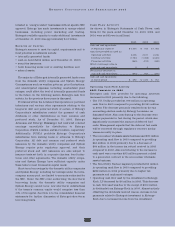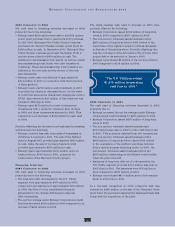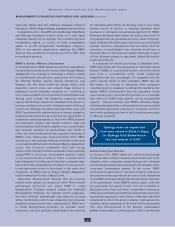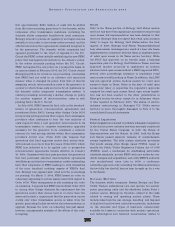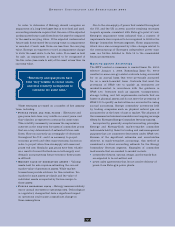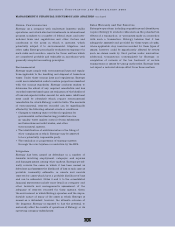Entergy 2003 Annual Report Download - page 41
Download and view the complete annual report
Please find page 41 of the 2003 Entergy annual report below. You can navigate through the pages in the report by either clicking on the pages listed below, or by using the keyword search tool below to find specific information within the annual report.
39
ENTERGY CORPORATION AND SUBSIDIARIES 2003
In the long-term, these changes may result in increased
costs associated with utility unbundling of services or func-
tions and transitioning in new organizational structures
and ways of conducting business. It is possible that the new
organizational structures that may be required will result
in lost economies of scale, less beneficial cost sharing
arrangements within utility holding company systems,
and, in some cases, greater difficulty and cost in accessing
capital. Furthermore, these changes could result in early
refinancing of debt, the reorganization of debt, or other
obligations between newly formed companies and Entergy.
As a result of federal and state “codes of conduct” and
affiliate transaction rules, adopted as part of restructuring,
new non-utility affiliates in Entergy’s system may be
precluded from, or limited in, doing business with affiliated
electric market participants, or have prices set at the lower
of cost or market. In addition, regulators may impose
limits on (price caps), rather than have the market set,
wholesale energy prices. There are a number of other
changes that may result from electric business competition
and unbundling, including, but not limited to, changes to
labor relations, management and staffing, structure of
operations, environmental compliance responsibility, and
other aspects of the utility business.
Transmission
In 2000, FERC issued an order encouraging utilities to
voluntarily place their transmission facilities under the
control of independent RTOs (regional transmission
organizations) by December 15, 2001. Delays in implementing
the FERC order have occurred due to a variety of reasons,
including the fact that utility companies, other stakeholders,
and federal and state regulators continue to work to resolve
various issues related to the establishment of such RTOs.
Entergy’s domestic utility companies were participating
with other transmission owners within the southeastern
United States to establish an RTO, the proposed SeTrans
RTO, but the sponsors determined that the regulatory
approvals necessary for the development of the SeTrans
RTO were unlikely to be obtained at the present time and in
December 2003 suspended further development activity.
Although SeTrans development is suspended, Entergy
continues to focus its efforts on reforms that can further
the core objectives of FERC’s 2000 order: achieving greater
independence in the provision of transmission service and a
more efficient method of pricing that service. Entergy
intends to work with FERC and Entergy’s retail regulators
on certain voluntary steps to further those objectives.
As currently contemplated, and assuming applicable
regulatory support and approvals can be obtained, Entergy
plans to contract with an independent transmission entity
to oversee the granting of transmission service on the
Entergy system as well as the implementation of the weekly
procurement process that Entergy has proposed. Entergy
will submit to FERC for its approval the proposed contract
setting forth the independent entity’s duties and obligations
as well as other documents necessary to implement this
proposed structure. The proposed structure does not
transfer control of Entergy’s transmission system to the
independent entity, but rather will vest with the independent
entity broad oversight authority over transmission planning
and operations.
Entergy also intends that the independent transmission
entity will administer a transition to participant funding
that should increase the efficiency of transmission pricing
on the Entergy system. Entergy intends for the independent
transmission entity to determine whether transmission
upgrades associated with new requests for service should be
funded directly by the party requesting such service or by
a broader group of transmission customers. This determi-
nation would be made in accordance with protocols
approved by FERC and any party contesting such determi-
nation, including Entergy, would be required to seek review
at FERC.
On February 13, 2004, a group of ten market participants
filed with FERC a response to the announcement that the
SeTrans sponsors had suspended further development
efforts. In their response, the participants allege that absent
the SeTrans RTO, the dominant utilities in the southeastern
United States (Entergy and Southern Company) will
continue to maintain control over the transmission system
and will continue to have the ability to exercise market
power in the wholesale market. The market participants
urge FERC to: (1) order Entergy and Southern to immediately
turn over control of their OASIS system to an independent
entity; (2) initiate a formal investigation into competitive
conditions in the southeastern United States; (3) issue a
show cause order regarding revocation of Entergy’s and
Southern’s market-based rate authority; and (4) either order
Entergy and Southern into an RTO or initiate proceedings
to appoint a market monitor and conduct various audits of
Entergy’s and Southern’s practices and procedures related
to the granting of transmission service and the planning of
the transmission system. Entergy believes that the allegations
contained in the response are without merit and plans to
“Entergy continues to focus its efforts
on reforms that can further the core
objectives of FERC’s 2000 order:
achieving greater independence
in the provision of transmission
service and a more efficient method
of pricing that service.”




